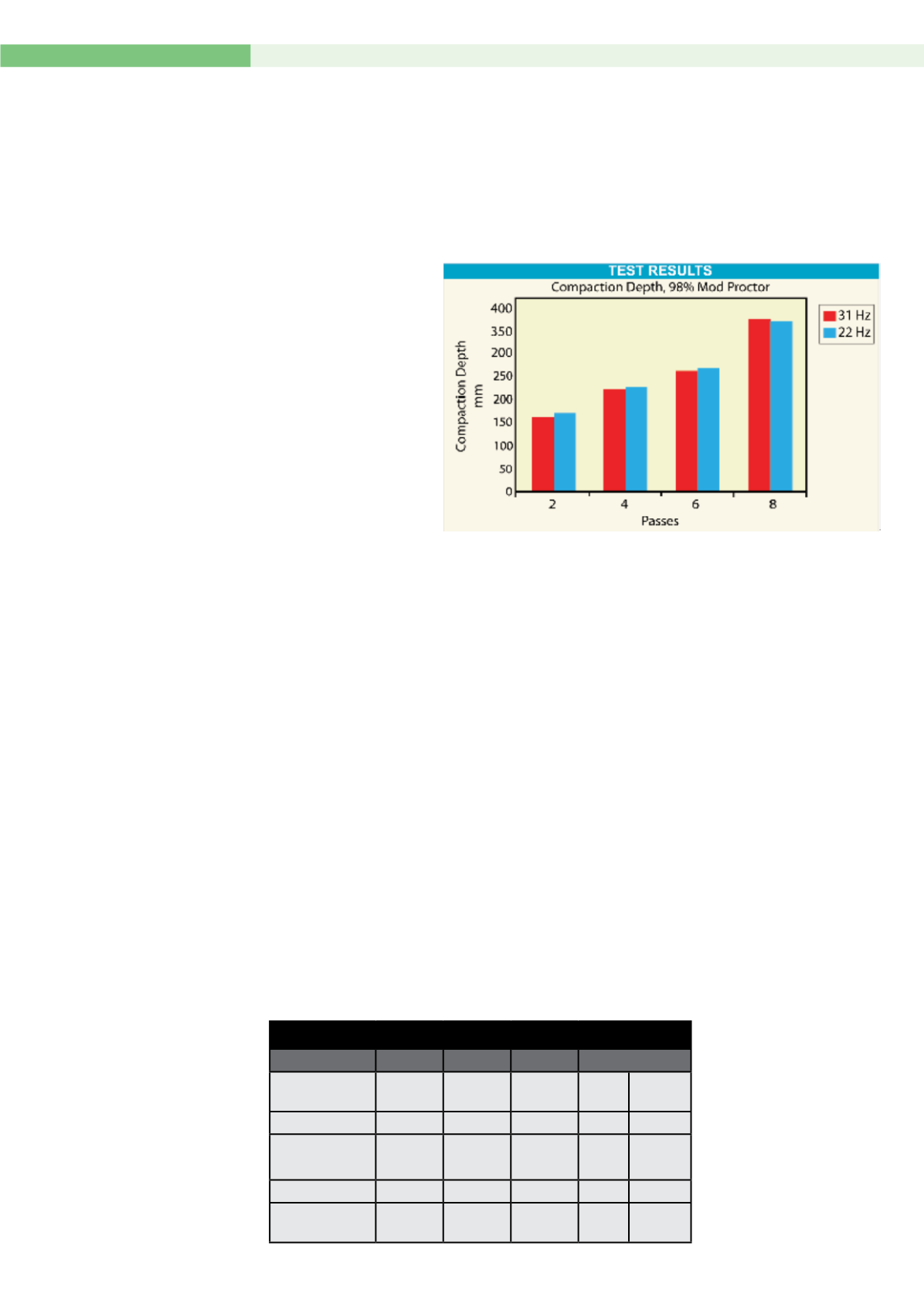
INDUSTRY IN FOCUS
18 | HIRE
AND
RENTAL
NEWS
| MAY 2014
For several decades Dynapac have
been carryingout exhaustive testingof
different compactionmethods andhave
firmly established thebasic principles of
vibratory compaction, whatworks andwhy
itworks. It iswell established around20Hz
(1,200 rpm) is attained, the acceleration
of gravity is overcomeand amplitudewill
not change irrespectiveof any increase in
frequency. At frequencies below20Hz, the
accelerationof gravity is not overcome
andonly elliptical or evenhorizontal linear
motion canbe achieved – limitedor no
amplitude.
Frequency – is the speedof rotationof
theeccentricweightswithin thedrum,
usually expressed inHz (cycles per second)
or VPM/RPM (vibrations or revolutions per
minute). As discussed above, the frequency
of the eccentricmust begreater than 20Hz
to achieve circularmotion.
With regard to theupper limit, the
frequency needs tobeappropriate for the
amplitude selected.
Correct proportions ofmajor
components
– For both soil and asphalt rollers, tests
of various configurations clearly indicate
that adrum to framemass ratioof 50:50 is
themost effective. A significantly heavier
drum transmits toomuch vibration to the
drum frame, whilea significantly heavier
frameprohibits full displacement of the
drum reducingamplitude.
For soil rollers (singledrum), thedrum
module shouldnot exceed around
70%of the totalmachinemass inorder
tomaintain the tractionand steering
benefits of the tractormodule. Asphalt
rollers (doubledrum) shouldhave a50:50
mass distributionbetween front and rear
modules.
Centrifugal force (FC) has beenproven
tobear nodirect relationship to
theefficiency of compactionby
vibratory rollers. This is simply
the radial forcegeneratedby
rotationof the eccentricmass
and is calculatedbymultiplying
theeccentricmoment (mass x
radius of the eccentric or “m.r”)
by the frequency (in radians per
secondor “
ω
”) squared. Being
a squared function, a small
increase in frequencywill result
ina large increase in centrifugal
force. It is useful for calculating
for the loadon eccentric
Debunking themyths of variable frequency
bearings, but
littleelse.
Thegraphs
above illustrate
a test thatwas
carriedout
with the same
roller on the
samematerial
at twodifferent
frequencies.
In the
example
above, where
thedifference
betweeneach
method is
shown tobe statistically insignificant,
there is clearly noadvantage inoperating
at a 41%higher frequency or 98%higher
centrifugal force. These results are typical
for all soil types tested.
What is the correct vibration frequency?
Wehave already demonstrated that a
minimum frequency of 20Hz is required to
achieve circularmotionof thedrum, but
in reality theminimum frequency needs
tobehigher to ensure it does not drop
below 20Hz under varying load conditions.
Usually 27Hz is adequate to ensure
constant circularmotion.
Theupper limit is less obvious and
really comes down to engineeringand
application limitations. Thehigher the
frequency, thehigher the centrifugal force.
Toohigh a frequencywill demand
unnecessarily large eccentric bearings.
Theamplitude (or vertical displacement)
of thedrum is themore important limiting
factor. The further thedrumneeds to
travel in the time allowed, thehigher it’s
mean vertical velocity. Adrummoving
1.7mm in 1/30thof a secondneeds to
movemuch faster than adrummoving
0.85mm in the same timeperiod.
The faster it travels, thehigher the
impact energywhen it comes into contact
with thepavementmaterial.
Toomuch impact energywill causenot
only acceleratedwear to themachine, but
alsodamage to thepavementmaterial,
specifically stonebreakage.
Again, having thebenefit of years of
testing, Dynapac have established that
there is very clear relationshipbetween
vibration amplitude/frequency and
stonebreakage. This relationship canbe
expressedas aunit less constant “K”of 45
whereK=Amplitude/Frequency2.
This constant is not a critical number and
anythingwith a “K” valuebetween25and
65 tends toproduce similar compaction
results. Thehigher the amplitude, the
lower the frequency needs tobe. The
lower the amplitude, thehigher the
frequency canbe. This is irrespectiveof the
material tobe compacted.
Withmodern features suchas Dynapac’s
EcoMode, engine speed canbe reduced
as a fuel savingmeasure.
When engine speed
is reduced, vibration
frequencywill reduce
proportionally. In this
event, thepumpoutput can
be increased tomaintain
a constant frequency.
Operator selected vibration
frequency is of little
value as it has not been
demonstrated that any
frequency ismore suited to
any particularmaterial.
HR
Machine Parameters
Unit
Test 1 Test 2 Difference
Static linear
load
kg/cm 28.0
28.0
0.0 0.0%
Amplitude
mm 1.7
1.7
0.0 0.0%
Eccentric
moment
kg.m 6.1
6.1
0.0 0.0%
Frequency
Hz
22.0
31.0
9.0 40.9%
Centrifugal
force
kN
117.0 232.3 115.3 98.6%
Manymanufacturers of vibratory rollers offer variable vibration frequency either as an
optional or standard featureon their equipment. Theaimof this document is todiscuss the
benefits, if any, of this feature.


